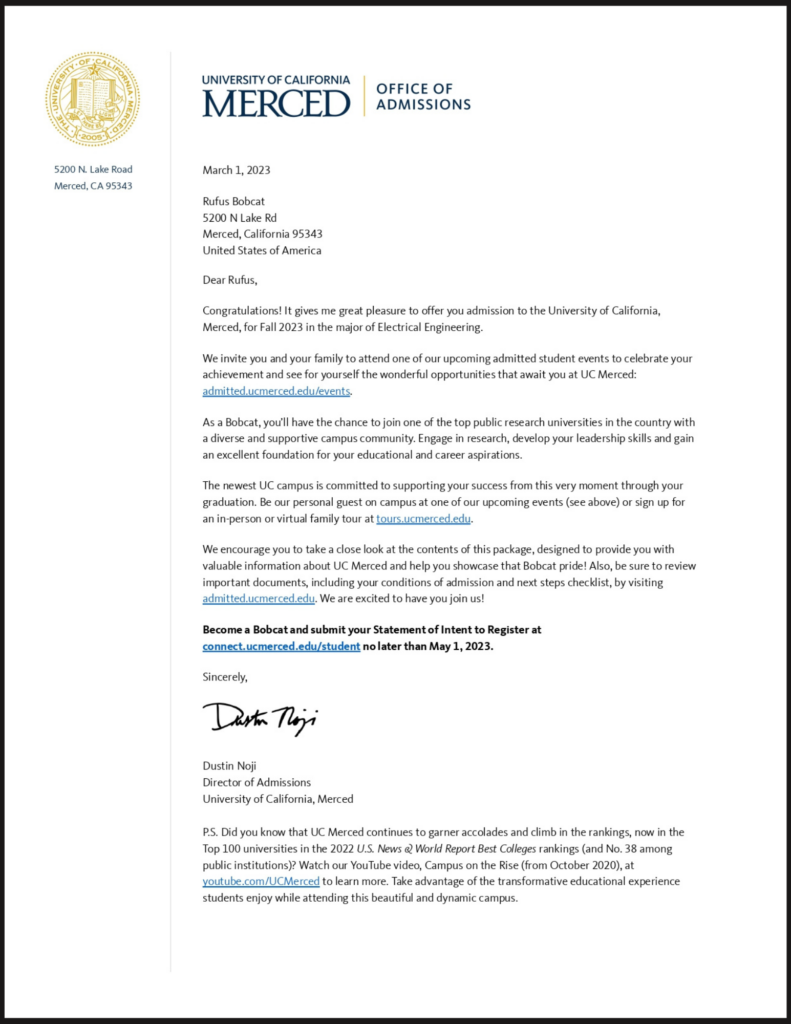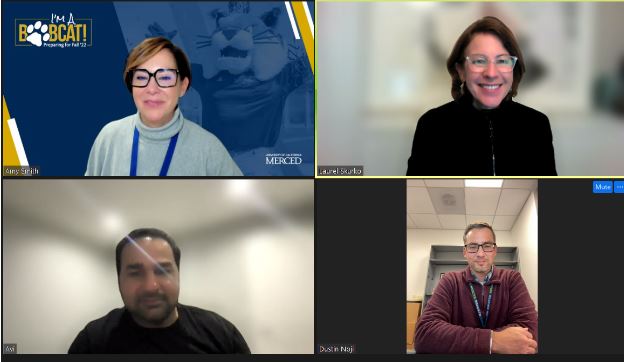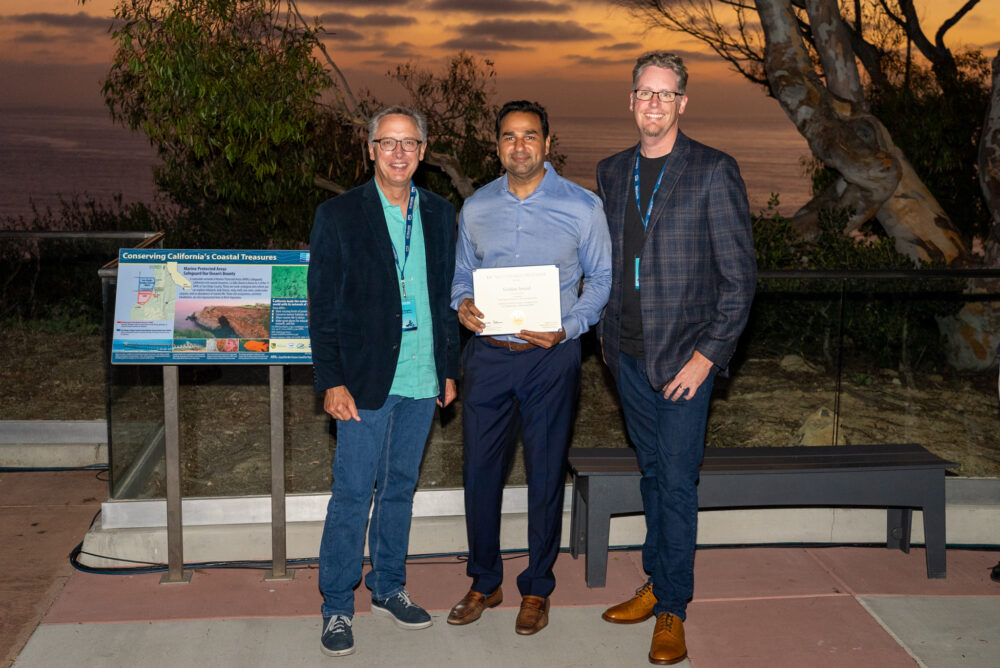By Laurel Skurko. It’s March in California. This means nearly 250,000 students who applied to the University of California (UC) last fall will soon learn the answers to their questions: “Was I accepted?” and “What’s next?” Thanks to a digital-first approach deployed in Spring 2022, the 27,000 students who applied to UC Merced are receiving answers to these questions in a new way. The project team behind this digital transformation won the UC Tech 2022 Golden Award in Design and recently spoke with the UC IT Blog team about their path to success. The clock is ticking for another cohort of UC applicants, just as it was for Avi Badwal and his project team when they started this project in September, 2021. Below, you will learn the discipline behind their project management that resulted in a successful customer experience and business outcome.

The Student Intent to Register (SIR) process and why it matters to students, admissions and the mission of the school
As college-ready students in California are well aware, the two-month period between March and May marks an important window of opportunity in the college application process. During this time, prospective students decide if they will accept the school’s offer of admittance and join the UC Merced community. The process starts with a “you have been accepted” announcement in March and culminates in the students sending their “intent to register” to the school in May.
The value of a strategic mind-set
The SIR process marks the first time the applicant is being welcomed by the campus as a future student. This online experience not only affects enrollment rates, but also sets the stage for the student’s sense of belonging and their ultimate success as an undergraduate. The legacy system that drove the old SIR process was outdated, difficult to use, and did not reflect UC Merced’s excellence as an institution. It also did not set the right tone for the university’s initial engagement with a potential student—with the old process, newly admitted students and their parents were told “you’re admitted!” in sad 12-point font, then were immediately confronted with materials that looked like a government form from the late 90s, complete with tables and codes which required squinting.
These issues would make the project viable at any institution, but it was prioritized at UC Merced because it directly supported the UC Merced 10-year strategic plan (2021-2031), which focuses on student success and equal opportunities for a diverse student body. This project recognized that as digital natives and largely first-generation applicants (more than 70% of UC Merced’s student body is first-generation, many of whom rely on financial aid), the students they were serving needed a different experience to appropriately mark and celebrate the momentous occasion of their acceptance into the University of California.
The result – A totally new experience – both visually and conceptually
- The new product went live (on time!) on March 1, 2022, which is also the day the university announced acceptances for its incoming 2022/23. Almost immediately upon launch, an entire generation of UC Merced applicants (more than 27,000!) benefited from the newly designed experience.
- The updated digital process is dynamic and mobile friendly as well as compelling to its target audiences. Newly admitted students and their parents are no longer confronted with materials that look like a government form—and no squinting required. Instead, they can celebrate one of the most important moments in their lives as Bobcats (UC Merced students) and literally visualize their journey to UC Merced.
- The revamped Road to UC Merced sets the tone for the school’s relationship with its applicants and their families while it also sets clear expectations for them as future students.



Key Success Factors
- Establishing clear goals: Focusing on the factors described above, the team created two principal goals: (1) create a celebratory experience to highlight this milestone in the lives of students and families alike; and (2) create a more straightforward ‘next steps after SIR’ experience.
- Looking at the problem in a new way: The project team originally attempted to apply a technology solution to what amounted to a paper-based system. Over time, the project stalled, and the team realized that it would be more expedient to start with a new, digital system. It was this insight which allowed the project to advance.
- Establishing and maintaining a tight timeline:
- Prioritizing customers’ needs to access the product: The team advocated for the students and their families who might benefit from the encouragement to attend college at all, and to come to UC Merced in particular.
- Disabling collaboration downstream in the project: In order to meet tight timelines, the team balanced the need for upfront collaboration with the need for a downstream speed. They did this by creating and enforcing a division of labor. After requirements were set and the project was in progress, only the function assigned to the next task could weigh in on the particulars of that task.
- Deploying UX Design methods:
- Assembled a cross-functional team, including Admissions, Marketing, Project Management, Business Consulting, User Interface/User Experience Design and IT;
- Analyzed user data, including exit survey results and support tickets across a number of teams such as the IT Service Desk and Admissions;
- Incorporated feedback during focus groups and conducted QA testing with Admissions student employees;
- Created student and parent personas (i.e., articulating the value proposition they offered each customer segment and how they would like to receive specific information);
- Created a communications plan with a clear information hierarchy;
- Allowed visual designers to generate concepts to guide communications to make it more relatable to broad audiences.

How one project success begets another….
This project’s approach and its resulting success opens the door to future improvement in this realm— because of the new technologies deployed and the trust generated among team members from across different functions.
Phase II will begin in 2023, and the team is excited about what lies ahead. Plans include an experience for students who have been wait-listed, incorporating innovations in cyber security and privacy, and the possibility of pop-ups, Easter eggs, and Virtual Reality (VR).
About the Project and the Project Team
The Improving the Road to UC Merced Project was received the Golden Design Award at the 2022 UC Tech Awards for creating a groundbreaking digital user experience (UX) for potential students, which not only met customer expectations but also reflected the university’s prestige while improving engagement and retention rates. The project ensured an optimal online journey for prospective students, featuring accessibility, intuitive navigation, and engaging visual design – all of which are crucial factors for success among “digital native” audiences. Read the team’s Original UC Tech Awards Application, and learn more about the 2022 UC Tech Awards winners: Celebrating collaboration, innovation.
Interdisciplinary Team Members
Information Technolgy, UC Merced
Avi Badwal, Interim Deputy Chief Information Officer, Office of Information Technology
- Avi Badwal, Interim Deputy Chief Information Officer, Office of Information Technology
- Joshua Swink, Programmer Analyst, Office of Information Technology
- Mohammed Zaidi, Senior Software Engineer & Integration Developer
- Matthew Faulkner, Enterprise Services Architect, Office of Information Technology
- Jean Nghiem Xuan, SIS Programmer Analyst, Office of Information Technology
Admissions, UC Merced
- Dustin Noji, Director of Admissions, UC Merced
- Amy Lozano-Smith, Director of Enrollment Management, Marketing, and Communications UC Merced
- Ruben Lubers, Associate Director Of Admissions, Operations, Admissions and Outreach Paul Flannery, Admissions Systems Analyst, Admissions and Outreach
Grateful for a rich discussion
The UC IT Blog team is grateful to the interdiscplinary team for taking time to share their story.

Photo caption (cover image): UC Tech Awards ceremony at UC San Diego in 2022, pictured left to right: Joe Bengfort, UCSF Chief Information Officer, Avi Badwal, UC Merced, and Nick Dugan, Chief Information Officer, UC Merced.
About the author:

Marketing & Communications
IT Services Department
UC Office of the President







